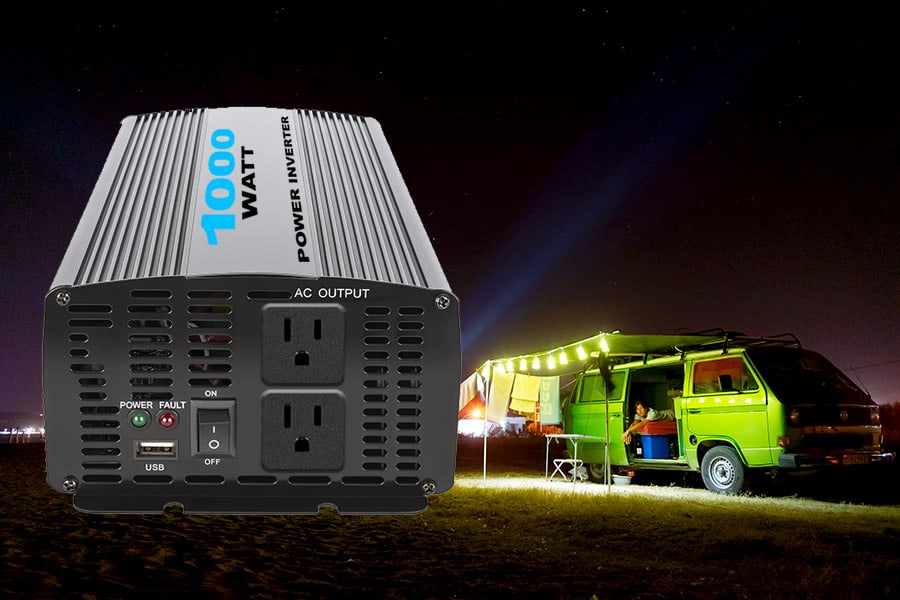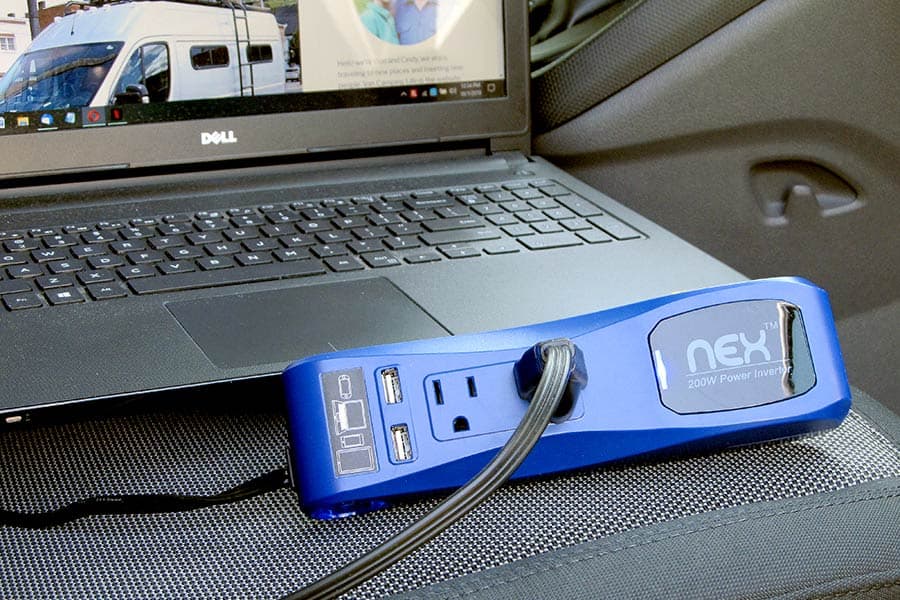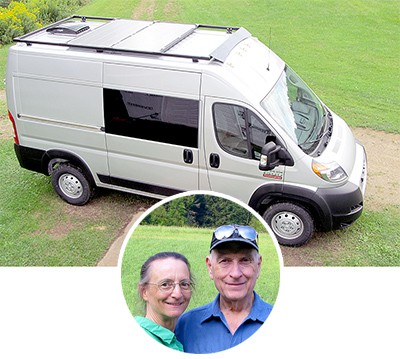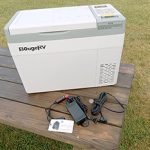
An inverter allows you to use the electrical devices typically found in your home while on the road. In a previous post, I discussed what an inverter is and why you might want one in your van build. If you haven’t already read my post, you can check it out here.
If you have decided that an inverter is a good idea, but now you’re wondering, “How do I select one?” The following tips will help you in making the right selection for your specific purposes.
Just to review, an inverter does two essential things. It changes power from your van’s existing DC power system from DC (Direct Current) to AC (Alternating Current). Then the inverter increases the voltage from 12 volts to a higher voltage – typically 120 volts AC in North America.
What Size Power Inverter do I Need for My Van?
The correct inverter size depends on the loads you wish to use in your van. How many items do you plan to have, and how much power will each item require?
The sizing of the inverter may also depend on whether the items you plan to power from your inverter will be used continuously or just now and then. By considering these “intermittent” or “peak” loads, you may be able to save money by purchasing a smaller, less-expensive “peak-rated’ inverter.
Inverter size is related to the size of your battery bank, or another way to say that is,” How much space do I have for my battery bank, and how much battery weight can my vehicle support?” Be aware that the size of the inverter and the size of the battery bank are interrelated – a larger inverter generally calls for a larger battery bank.
Also, decide if having two separate inverters – a larger one for motor loads and a smaller one for sensitive loads – makes sense in your application. Why? You may be able to use a less-expensive modified-sine-wave inverter to run those larger loads. If so, size each inverter independently.
How do I go About “Sizing” My Inverter?
The power required for each item will typically be rated in “watts.” You can find the watts used by each item on the item’s nameplate. If not on the nameplate, check the user’s manual or manufacturer’s web site. A web search may provide the answer to your device.
For convenience, here are some typical wattages for items used in a van:
- Fridge – 180 W
- TV 32-inch LED – 40 W
- Microwave – 1000 W (requires 1250 – W)
- Toaster – 850 W
- Laptop – 75 W
- Satellite Dish – 15 W
- Box Fan – 80 W
- CPAP – 50 W
- BluRay Player – 10 W
- Blender – 1560 W
Manufacturers of some items, such as LED TVs, may be coy about directly indicating the power required. In the above example, it was necessary to refer to the manufacturer’s Energy Guide label, then compute backward to find that a typical 32-inch LED TV will draw approximately 40 watts.
WHAT’s a WATT? You may be thinking, WHAT is all this “WATT” stuff? A watt is simply a measurement of electrical power usage. The best way to determine power usage is to get it from the device nameplate or user manual. If the manufacturer does not indicate wattage, it may be calculated: simply multiply volts by amps.
Make a list of the items in your van, including items you will be adding in the future. Total the “watts” rating for all items, then add 20% for a “fudge factor” (multiply total watts by 1.2.)
Let’s run through two inverter-sizing examples:
Example 1, Easy-Peasy:
Assume that you will be running a 32-inch LED TV, a typical laptop, a box fan, and a satellite receiver. The TV will typically require 40 watts, the laptop 75 watts, the box fan 80 watts, and the satellite receiver 15 watts; this gives a total load of 210 watts.
Multiplying 210 watts by the 1.2 “fudge factor” results in 252 watts. In this scenario, you would buy a 250-watt “continuous-duty” inverter.
Example 2, A Little More Complicated:
Assume that you will be running a 32-inch LED TV, a typical laptop, a blender, and a satellite receiver. The TV will typically require 40 watts, the laptop 75 watts, the blender 1560 watts, and the satellite receiver 15 watts; this gives a total load of 1690 watts.
But wait a minute. Unless you are making smoothies 24/7, that blender will only be running a couple of minutes now and then. But when it DOES run, you’ll need 1690 watts – intermittently! Notice that many inverters are given an “intermittent” or “peak” load rating as well as a “continuous” load rating.
Okay, looking at it from another angle, the manufacturer is saying that you can operate an inverter in a temporarily overloaded condition and get away with it, but only if they so state in the specs. And also notice, that many inverters’ “peak” ratings are about twice their continuous ratings.
So, in this case, you would purchase the inverter based on your “peak” rating of 1690 watts. Yes, there are 1700-watt “peak-rated” inverters available. Their “continuous” rating is 850 watts, half the “peak” rating.
Let’s look at this “peak” thing a little closer. Do you also have a microwave? Look at the chart above – a 1000-watt microwave consumes less power than the blender. A toaster will probably draw less power than a microwave. So how do you select an inverter when you have multiple intermittent loads?
Size your inverter for the total of the continuous loads, PLUS your single largest peak load as we did above to get 1690 watts and forget the 20% fudge factor. Remember, just don’t run the toaster when you are running the blender. What about the continuous loads? They added up to 130 watts, far below the inverter’s 850-watt “continuous” rating.
Other Posts of Interest
- What is Van Camping?
- 11 Ways to Stop Condensation When Sleeping in a Van
- How To Clean Your Camping Stove And Burners: 16 Tips That Work
Low Cost vs. High-Cost Inverter
Generally, lower cost equals lower quality and lower suitability. For any given inverter output, the square-wave inverter will be the most economical, increasing to modified-sine-wave, increasing to true-sine-wave. The true-sine-wave will power any type of load reliably and also is the most expensive.
Square wave, modified, and true-sine wave inverters were discussed in our earlier post here.
As mentioned above, if you have intermittent loads like a blender, purchasing your inverter based on its “peak” or “intermittent” rating will generally allow you to buy a smaller, less expensive inverter.
What Should I Consider When Buying a Power Inverter?
One of the most important things is the type of inverter: square-wave, modified-sine-wave, or true-sine-wave. The type of loads will determine which you buy. Also, it may be more cost-effective to buy two inverters, using a smaller higher-quality one for sensitive loads
- Low audio noise – some inverters may emit a loud buzz, especially the cheaper ones.
- Some inverters have a built-in low-voltage disconnect, which will shut down the inverter before completely discharging your battery bank.
- Some have ignition sensing and run only when the van engine is running.
- Other features to consider may include an audio alarm and built-in metering for input voltage, output voltage, frequency, and load monitoring.
What should I consider when choosing one to put in a van conversion vs. an inverter for home or commercial use?
- Noise – physical – many inverters produce an annoying noise or hum. If you are mounting the inverter in the living space of the van, check the specs to ensure that it is rated for quiet – low audio noise in dB.
- Size and weight – both are at a premium in mobile applications.
How do I Choose a Power Inverter for My Van Conversion?
Choosing anything is always a tradeoff. Quality, price, value, efficiency, benefits, and features will all roll into your decision. Carefully check the manufacturer’s recommendations for both the inverter and prospective loads before making your final decision.
Don’t worry; we’ll help.
At this time, depending on your loads, you already know the type of inverter(s) you are going to buy: modified-sine-wave for heavy loads, true-sine-wave for sensitive loads. If in doubt, select a true-sine-wave type. You also have seen how to figure the required size rating in watts – don’t forget that you can size to a smaller inverter if using intermittent loads – see above.
1. Select the inverter type and size rating. As seen elsewhere in this post, finalize your list of equipment and add up the total loads. If dividing the loads between 2 separate inverters, total the load for each one independently. The total load on the inverter(s) is the inverter size in watts.
- If the size is slightly over a common size, go with the smaller common size. If 10% or more over, jump to the next size. Better too big than too small.
- Don’t forget: the inverter(s) size rating will determine the size of the battery bank. If you are powering more loads, for a longer time, the size of the battery bank will need to be increased. It’s a circle: if you want a smaller battery bank, reconsider which electrical items are “essential.”
- OR, if you already have a battery bank, inverter size will be determined by your EXISTING battery bank, unless you decide to upgrade the battery bank.
I am an AMP! You may be wondering, what is all this “Amp” stuff? An amp is simply a measurement of electrical flow and is analogous to water flow in a pipe. The higher the amps, the greater the amount of current flowing through the wire and to the load. The higher the amperage, the higher the current flow; the higher the heat or power consumed, the larger the wire required.
2. Compute the MINIMUM size of required battery bank:
(A)
- If using Deep-cycle FLA batteries, multiply the total inverter(s) size(s) by 0.67.
- If using AGM batteries, multiply the total inverter(s) size(s) by 0.33.
- If using Lithium batteries, multiply the total inverter(s) size(s) by 0.17.
Remember, if you decide to upgrade from FLA to AGM or Lithium batteries, you are not necessarily gaining any storage capacity. What you are gaining is the ability to discharge the battery bank at a greater rate, without diminishing the service life of the battery.
- AGM batteries may be discharged at a higher rate than FLA.
- Lithium batteries may be discharged at a higher rate than the other two types without damage.
- For all types of batteries, ensure that the manufacturer’s maximum discharge rate is not exceeded.
(B)
- This gives you the minimum battery amp-hour rating. If your battery bank amp-hour rating exceeds this calculated value, then you are set.
- If the battery amp-hour rating is less, changes will have to be made. You may decide to remove loads, downsizing the inverter(s) until the bank amp-hour rating exceeds the number in 2(A). You may add more batteries of the same type until the bank amp-hour rating exceeds the number in 2(A).
- OR you may decide to upgrade from FLA to AGM or Lithium batteries, which allow a higher discharge rate for a given amp-hour rating. AGM batteries will provide a maximum discharge rate approximately twice FLA; Lithium approximately four times FLA.
3. Decide what options you would like – Bluetooth connectivity, low-noise, auto low-voltage shutdown, ignition-switching, built-in metering, alarms, etc.
4. Use the above criteria to search for the best inverter deal for you.

Do I Need Two Batteries?
If you are just one person out exploring on a 3-day weekend, you may be able to get by with a small inverter that plugs directly into your vehicle’s cigarette lighter. This setup would utilize your vehicle’s battery. No extra battery required.
If you require more equipment to outfit your van and want to stay out longer, you may need two batteries or MORE, configured as a “house” system.
Many vanners add a second “house” power system, which is somewhat separate or isolated from the vehicle’s “showroom” DC system.
Why? Multiple Reasons:
First, it is good to run the “house” electricals from a separate system to conserve and protect the vehicle’s battery. If you are watching TV in the boonies and accidentally run down the vehicle’s battery, how would you start the vehicle?
Also, the vehicle’s battery isn’t designed to power electrical devices over a long period of time; the vehicle battery is designed to provide a large burst of power over a short time, as in starting the engine. Using it to power electrical loads over an extended time will shorten its life.
Secondly, the opposite is true of batteries designed for “house” use. They are designed for powering low-energy loads for an extended period of time until the battery is nearly exhausted, hence the moniker “deep-cycle.” This type of battery normally has a slightly lower output voltage and benefits from a lower charging voltage – which may mean that an auxiliary charging system is best for this type of battery.
Charging the “house” battery system at the higher voltage required by the vehicle battery may decrease the life of the “house” battery due to overcharging and may cause the battery to “boil over.”
Utilizing a separate “house” battery system with an isolator and separate charging system may be best.
If you plan to camp in the boonies and run your electricals and electronics for extended periods without recharging your “house” batteries, you may find that two or more “house” batteries will be required.
Rule of Thumb for Matching Battery Bank to Inverter Size:
Once you have calculated required inverter size in “continuous” (not “peak”) watts, divide the inverter size by the following:
If using this type of battery: Divide inverter watts by this number for minimum amp-hour rating:
- Flooded Lead-Acid: (FLA) – 1.5
- Absorbed Glass Mat: (AGM) – 3
- Lithium: – 6
How Long Will the Inverter Run Until the Battery Runs Down?
The length of time is dependent mainly on the size of your battery system (rated in Ah – Amp-hours), the efficiency of the inverter, and the total load on the inverter. Obviously, this would be determined by your equipment and how you choose to use it.
Let’s run through a battery bank and inverter-sizing example:
Let’s assume that your battery supply is a size 27 FLA, flooded-lead-acid, marine deep-cycle battery. These batteries have a typical rating of 90 Ah. Also, assume that you will be running a 32-inch LED TV, a standard laptop, a box fan, and a satellite receiver. The TV will typically require 40 watts, the laptop 75 watts, the box fan 80 watts, and the satellite receiver 15 watts; this gives a total load of 210 watts.
Assuming the inverter has an efficiency of 85%, the inverter would draw 248 watts or about 21 amps from the battery. Assuming a fully charged battery capable of 90 Ah, the battery in this example would last a little less than 4-1/2 hours. Whoops!
This is a bad example – in this case, the amp-hour rating of the battery is too small for the desired inverter rating. This type of battery, FLA “deep-cycle,” will give the longest service life if it discharged over a period of 20 hours or more. We’ll discuss this further below.
However, running TV and satellite only, a total load of 55 watts, the battery would be dead in about 16 hours. This is closer to the “ideal” 20-hour discharge rate and will help increase the battery’s service life.
Note also that in the above examples, the first example would not be good for your battery. In order to achieve the best battery life, the discharge rate of any battery should not exceed a given amount.
The rule of thumb is that for a deep-cycle flooded-lead-acid battery, the maximum discharge rate in watts should not exceed 1-1/2 times the battery’s rating in amp-hours. This rule of thumb calculates discharge in approximately 10 hours, about half the “ideal” rate.
So in our example above utilizing a single 90 amp-hour battery, the maximum inverter load would equal 90 (the battery’s amp-hour rating), times 1-1/2, for a total of 135 watts. In other words, 135 watts would be the maximum rating for an inverter powered by this battery. Since 135-watt inverters are not available, you would purchase a 150-watt inverter and operate it with a less-than-maximum load – 135 watts.
In order to use all four devices in the example above, you would need a different battery bank, one with a minimum of 170 amp-hour capacity. You could either add another similar battery to the battery bank for a capacity of 180 Ah or switch to another type of battery.
The rule of thumb for maximum inverter size for an AGM (Absorbed Glass Mat) battery is three times the amp-hour rating. Utilizing a Lithium battery, the maximum inverter size may be up to six times the amp-hour rating of the battery.
Let’s look at this more closely for AGM and lithium batteries:
In our example above, all four devices would present a total load of 210 watts to the inverter. Using a size 27 AGM 90 Ah battery instead of FLA, the allowable maximum inverter size – in order to reach maximum battery life – is 90 times 3, or 270 watts.
Since 270-watt inverters are uncommon or unavailable, you would buy a 250-watt inverter, which would help ensure long battery life because it is less than the maximum inverter size rating of 270. The 250-watt inverter would also be large enough to power our four loads, as its capacity exceeds the 210 watts drawn by all four loads.
In our example above, all four devices would present a total load of 210 watts to the inverter. Assuming lithium batteries are available in 90 Ah sizes, the allowable maximum inverter size – in order to achieve maximum battery life – is 90 times 6, or 540 watts.
What Features Should I Look for in an Inverter?
Consider buying an inverter with a built-in low-voltage shutdown. This option will shut down the inverter before draining the batteries completely, which will extend battery life. Other features include overload trip, over-temperature trip, low voltage alarm, low voltage disable, high battery power off, reverse polarity protection, and short circuit protection.
So that pretty much wraps it up for selecting an inverter.
Just Remember
If not using a separate “house” battery, shut down your electronics while there is still plenty of reserves left in the battery for starting the engine. The further out in the boonies you are, the more important this is!
We enjoy van camping, but sometimes we want some of the comforts of home. In some locations we have been, there hasn’t been an electrical source readily available. When camping and you want to work using your laptop, you need electricity; you can’t go days without re-charging. By having an inverter installed in our van, it gives us the best of both worlds.
Using high-tech electronics in your conversion van can make your life easier, more enjoyable, and safer. Selecting and installing the proper inverter for the type of use you need is essential and will increase your enjoyment of your van camping experience.
Van Camping Life Disclaimer: We are not electricians; we just van camp as a pastime/hobby. While writing this post, we put hours of time and effort into researching this topic to provide you with the most comprehensive information that we could give you.
All aspects of working with electricity are dangerous and can have severe consequences if not done properly.
Research any electrical projects thoroughly, get additional help from a licensed electrician or have a licensed electrician do your complete electrical project.






